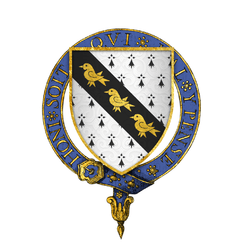John Cheyne, Baron Cheyne
John Cheyne (or Cheney), Baron Cheyne KG KB (ca. 1442[1] – 1499[1][2]) was Master of the Horse to King Edward IV[1][3] and personal bodyguard to King Henry VII of England.[1]

Biography
John was the third but second surviving son of John Cheyne (or Cheney) of Shurland Hall in Kent, by his wife, Eleanor, daughter and sole heiress of Sir Robert Shottesbrooke of Faringdon in Berkshire (now Oxfordshire).[1] He was the uncle of Thomas Cheyne, Lord Warden of the Cinque Ports[1] and grand-uncle of Tudor soldier and MP John Cheyne.[1]
In the 1460s he was appointed Esquire of the body to Elizabeth Woodville, Queen of Edward IV. He was MP for Wiltshire in 1478,[4] and in 1479 was appointed Master of the Horse. In the same year he married Margaret Chideock, eldest daughter of Sir John Chideock, and widow of William Stourton, 2nd Baron Stourton. Some sources say that they had a son who predeceased his father.
He was present when the Treaty of Picquigny was signed in 1475, and remained behind as a hostage of King Louis XI of France until King Edward IV had gone back to Calais and thence to England.[1][3]
After the death of Edward, and the seizure of the crown by Richard III, Cheyne switched sides to support Henry Tudor's claim to the throne by whom he was knighted in 1483 after their arrival in England from exile. He fought in 1485 at the Battle of Bosworth Field. When Richard III launched his last charge directly at Henry, Cheyne was part of Henry's personal bodyguard. Richard unhorsed him with a blow from his broken lance.[1] He fought again at the Battle of Stoke in 1487.[1][2] In 1486 he was made a Knight of the Garter and was called to parliament as Baron Cheyne.[1]
He lived at Faulston Cheyne in Wiltshire and Enborne in Berkshire.[1] Nicknamed the "Vigorous Knight" by contemporaries, he was a massive man of redoubtable strength. A 21" thighbone, found in his tomb at Salisbury Cathedral in the 18th century, puts his estimated height at 6 feet 8 inches.[1]
He had no surviving issue and the title died with him. His estates passed to his brother Robert.
References
- Ford, David Nash (2010). "John Cheney (c.1442-1499)". Royal Berkshire History. Nash Ford Publishing. Retrieved 29 November 2010.
- Lundy, Darryl. "Person Page - 21644". thepeerage.com. Retrieved 13 September 2008.
- Philippe de Commines. "Memoirs: Book 4 – The war of 1475". Richard the Third Society. Archived from the original on 11 October 2008. Retrieved 13 September 2008.
- Wedgwood, Josiah C. History Of Parliament (1439-1509).